It is Friday morning. My friends and I discuss hangovers, The Second Sex, push-up bras and flooded DMs with the slick familiarity of a generation raised by the internet to ‘Milkshake’ and women’s marches, to fourth-wave feminism and Kylie Jenner. The culture right now is coolly specific; we are both its victims and its life force. Then, in voices raw with concern, we begin to talk about our juniors from school—twelve and thirteen-year-old girls—who are dancing in crop tops on TikTok and posting self-confessed thirst traps on their Instagram stories. As we pick out outfits for the day, we mourn that which we have lost, and we mourn that these girls have lost it so young.
It is no grand revelation that the internet has permanently changed the way we interact with our bodies and our self-worth. What is particularly disturbing to me, however, is that the internet has created a culture encouraging—prescribing, even—that young women position themselves as sexual objects because it provides gratification, because it is being branded as ‘liberation,’ and because it is what is normal. In other words, young girls and women have internalised the antediluvian idea that their self-worth is fundamentally linked to their ‘sex appeal,’ as crafted by the male gaze. They now actively participate in their own sexualisation – through self-policing, women ‘subjectify’ themselves.
Before this progresses any further, this is not a page from a burn book intended to slut-shame women who may very well be more liberated than ever before. This is not intended as a moralising diatribe from a puritan uncomfortable with women owning their sexuality. Instead, I am only constellating the fears and discomfort that personal observation and experience have shown me. In India, by and large, this online phenomenon of self-sexualisation is restricted to a painfully privileged, Westernised subsection that is exposed to Eurocentric aesthetics of liberalism and its various media. In parts of the West, I believe it is far more pervasive.
Of course, like the issue of sexist dress codes and victim-blaming, primary fault lies with the paedophilic men who sexualise young girls. Fault lies with this pornified era’s boys who create group chats to sling commentary about girls’ bodies. Fault does not lie with the girls themselves. But the lecherous male gaze exists when women are covered from head to toe, and it exists when women are stark naked; it is independent of women’s choices in how they dress and represent themselves.
Further, sexualisation at the hands of the external male gaze is a well-documented problem within feminist discourse. My concern lies with the girls themselves: have they—we—been socialised into believing that our self-worth is linked with our sex-appeal, best determined by the malevolent gods of Instagram likes?
Platforms like Snapchat, Instagram and Tik Tok are flooded with girls who are consciously and subconsciously modelling themselves based on whichever newest construct of beauty is trending today. Right now, the ideal woman is ‘thicc’ but not fat, has pouty lips, a slit of a nose, doe-eyes, and baby skin. The internet, a proud parent, shows off all her du jour empowerment; she knows her angles like the back of her hand, and her framing of the shot rivals a professional photo shoot (she thanks Cosmopolitan’s handy 10 Ways to Take The Perfect Thirst Trap).
For years, and certainly today, institutions such as religion, marriage, and capitalism have been falling over themselves to keep women silently confined wherever it best serves the interests of those in power. As feminists all over the world labour to dismantle these structures of oppression with which we are so familiar, I fear that the patriarchy is keeping up with contemporary feminist movements. I fear that misogyny is mutating into murkier, unrecognisable, and internalised forms. The allodium of social media is one of the few places where women have the explicit power to control the representation of their bodies. But what does this representation look like? Is it the product of unfettered agency and an informed choice? Or is it the illusion of empowerment still trapped in a firmament of misogyny and hypersexualisation?
For decades, radical feminism slammed the beauty industry as an exploitative, consumerist evil. Today, internet feminism is dominated by the corporeal optics of womanhood. Sections of feminist movement which have huge virtual followings such as lipstick feminism or sex-positive feminism have been pushing to celebrate reclaiming the sexual power of women and championing high-femme accoutrements. Think high-heels, glitter lipstick, and tube tops off of Fashion Nova. These industries brazenly mistreat female labour. Their profitability is a function of how well they can sell the crippling beauty myth. Yet today, most glaringly so online, liberal social justice circles seem to be detaching from this anti-capitalist rhetoric and moving towards some simulacrum of an almost advertorial lexicon of consumerist empowerment. Two pieces of boilerplate feminist art I found with a cursory internet search chalk this transition out.

Popular neoliberal feminism not only partakes in the consumerism of influencer culture, but it also thrives in it. While there is a growing number of intersectional feminists who acknowledge the disproportionately gendered, racial and classist injustices of capitalism’s blood diamonds, there are simply far more feminists (myself included) who are still conditioned to abide by the steely infrastructure of social media all the same. The path to victory is paved with unobtrusive clarion cries for vague, directionless empowerment and apolitical, shareable stories. It is a game—a watershed game in the fight for justice, but a game nonetheless—and there are rules. Everyone on it, including feminists, must vie for the largest platform. And Instagram’s architecture is built around an unrelenting commodification of the body; black and white selfies will get more traction than informative posts about femicide in Turkey. The means justify the ends, so play the game. Build a brand. The goal is awareness, but awareness can be achieved only by plumbing virality. So, go viral. Talk about body positivity till the cows come home. Encourage your followers to post their own #BikiniBody pictures. “You’re gorgeous,” the internet will declare, “more power to you.”
It would be foolish and irresponsible to dismiss the worth of Instagram’s liberal feminists. They educate and engage individuals who would otherwise never have bothered with understanding oppression. Feminism is no longer a misandrist caricature of a mythical bra-burner, she’s the barely-teenaged girl posting dance videos of herself wearing whatever she wants. But without detracting from the genuine value of making feminism accessible to the young girls on the platform, I do think there is a critique to be made that, at its worst, what is being peddled so freely as ‘liberation,’ does not translate as a celebration of choice. Instead, it has become another misogynistic iteration that one’s worth is conceived in terms of their body and how well it has been conditioned to suit the bespoke measurements of the male gaze.
The failings of liberal feminism, extensively documented in feminist literature and discourse, are woefully absent from mainstream feminist platforms online. Indeed, both its prime agenda of being palatable, and social media’s explicit purpose to attract the masses have diluted contemporary feminism’s once “tendentious” politics that called for revolution. Liberal feminism considers women to be rational, individualist actors making independent choices without addressing their oppression as entrenched in a larger system of misogyny. It emphasises individual agency and self-promotion. Hypersexualisation is simply one instance where liberal feminism’s refusal to engage with wider, intangible relationships and the unequal structures of gender is to blame.
As social justice has become a major interest for young people, it does matter what the popular feminist movement is militating against, for our purposes—slut-shaming and fatphobia. Equally important is what it appears to be not militating against—the intractable importance of one’s body, the generational addiction to instant-gratification which sustains apps like Instagram, institutionalised patriarchy, and finally, the rot of self-sexualisation.
Because self-sexualisation is the product of the culture I described as “coolly specific,” in that it is thirst traps and casual hook-ups, trigger-happy online shopping and gaggles of Cool Girls. It is the myth of empowerment caught in the leer of the male gaze. For our lives are breathed in the limitless swell of the cloud. We post everything. We spend hours choosing captions and outfits and filters. We scroll till the ends of the earth. Social media’s ethically dubious algorithm is crawling with swarms of ridiculously attractive people, and our feeds are filled not just by the plasticised Kylie Jenners and Bella Hadids, but by our classmates and colleagues. As iPhone cameras get clearer and FaceTune gets more common, everyday women around us are looking more and more like models from magazines selling us boxes of sex with sides of insecurity. Social media democratised photoshoots and selling sex, and with that, it also democratised the pressure to sell yourself for social, emotional and capital gain.
In the famous ‘Looking Glass Self’ theory, sociologist Charles Cooley proposed that we base our behaviour and self-worth on what we perceive to be others’ opinions of us. If we perceive that others think of us as attractive or affable or interesting, we curate our personality as a person who is attractive or affable or interesting. Our self-worth is contingent upon how we perceive their assessment of us. I believe social media has transformed this abstraction of “perception” to the quantifiable yet hopelessly reductive metric of likes and followers.
Increasingly, our online presence is being viewed as an authoritative extension of ourselves; the carefully-selected tiles represent our interests, our friendships and our ‘clout.’ Unsurprisingly then, self-worth becomes reliant on social media relevance, which, in turn, is predicated on commodifying one’s body. This is because posts that are ‘sexy’ or ‘appealing’ just get more likes; our conception of what is ‘sexy’ or ‘appealing’ is embedded in centuries of misogynistic conditioning. But the instant-gratification of Instagram posts is temporary, leading to a drop in self-esteem, mandating another post with self-objectification. The cycle never ends. Slowly, almost unnoticeably, self-worth becomes just a number on a screen.
And where does that leave us? It’s somewhat of a cliché to bewail how, with every passing generation, kids are being forced to grow up faster and faster. In this instance, I am convinced it is true. Girls who are 14 and 15 right now have been socialised in a climate of hyperreal interactions and a parasocial empire of images. Their bildungsroman includes the startling successes of people like Alexis Ren— just 15 when she began posting photos of herself in swimwear because she “realises sex sells—and she’s OK with it,” and who eventually became a viral sensation on Instagram.
There is something deracinating about feeling like you must sexualise yourself to “be someone” or to “get something.” The image of a woman who owns her sexuality shimmers luridly as if designed by capitalism’s commercials and panderings to the patriarchy. I cleave feeds and film reels and wonder: why the hell does feministic sexual liberation look so much like a heteronormative male fantasy?
The more integrated our reality gets with our online personality, the more difficult it is to distinguish where one’s online influence ends and self-worth begins. It goes without saying that we should not be basing our self-esteem on an arbitrary number on a screen, much less a number determined by how best it fits into a patriarchal mould. But all around, we see the conventionally “hottest” women we know receive the most likes. And then it becomes too clear: certain kinds of outfits, behaviour, and poses work. Women might feel pressured to flirt or dress provocatively during an interview. This, too, works, albeit in a far less mathematical or algorithmic way than social media. By “work,” I mean they adhere to misogynistic standards. They offer pyrrhic shots of validation and opportunity in a “man’s world” without actually threatening the oppressive world itself. Trying to unshackle women from the patriarchy is exhausting when we are socially rewarded for our compliance with it. It is the same vicious cycle on loop; harsh reinforcement for an unwilling subject.
On a personal level, it has taken years to introspect about how this pressure to sexualise myself operates. I am still lost in the liminal spaces contemplating where choice ends and where internalised misogyny begins. For many women my age, the pressures of self-sexualisation are suffocating. But for those younger than me—girls who made their social media profiles when they were ten years old—the pressures are invisible. The paradox I straddle of misogynistic hypersexualisation and attempts to find liberation is no longer presented as a paradox, because this is the only reality available to them.
While the objective of a lot of liberal feminism is reclaiming one’s sexuality, coerced self-sexualisation feels a lot like giving it away. Like it isn’t yours anymore. The faceless patriarchs of the interwebs will tell you what you’re worth, and you will say thank you. While my friends and I mourn losing some control of our sexuality to interviews with ulterior motives and outfits picked specifically to impress, we also mourn for the girls who are being denied the opportunity to conceive a representation of their bodies that is neither adjudicated by the male gaze nor self-scrutinised to the point of obsession.
Self-worth cannot become an oscillating wind vane. Our bodies cannot become currency in the cruel economy of social media. We must reflect upon what real choices women can make when bound by patriarchal psychology. We must guard against the knee-jerk impulses we have been taught that push us to give more than we’re comfortable giving, irrespective of the promised gains. We must be willing to dispense with the obdurate foundations of our society and psychology, in order to build new palaces of air and fluidity. It is only then that we may see meaningful empowerment.


